
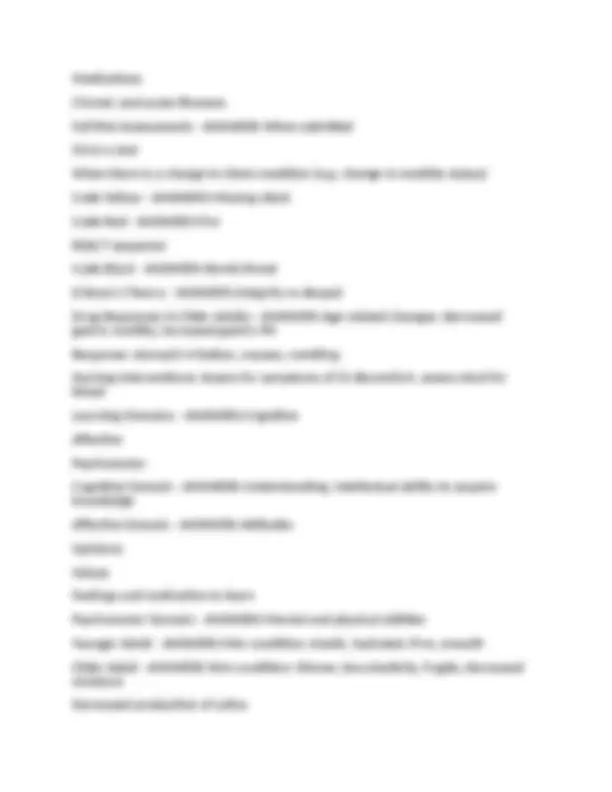
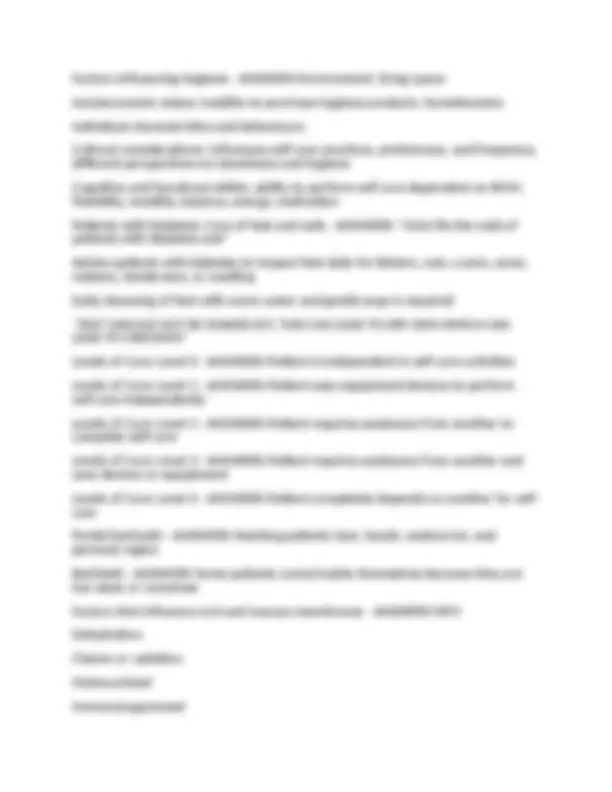
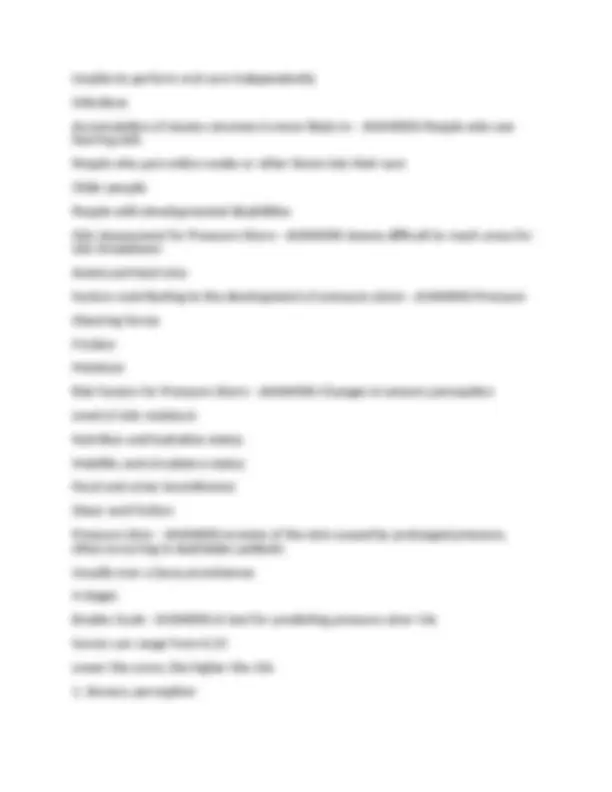
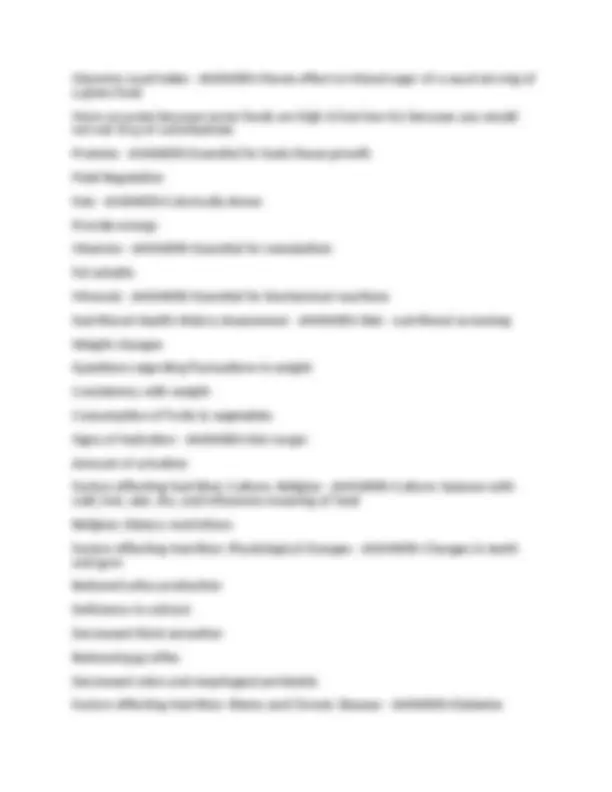
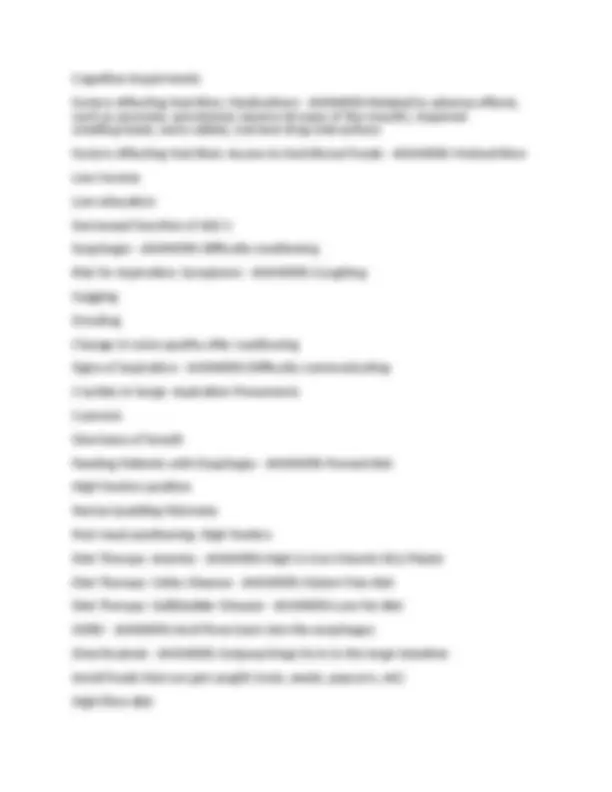
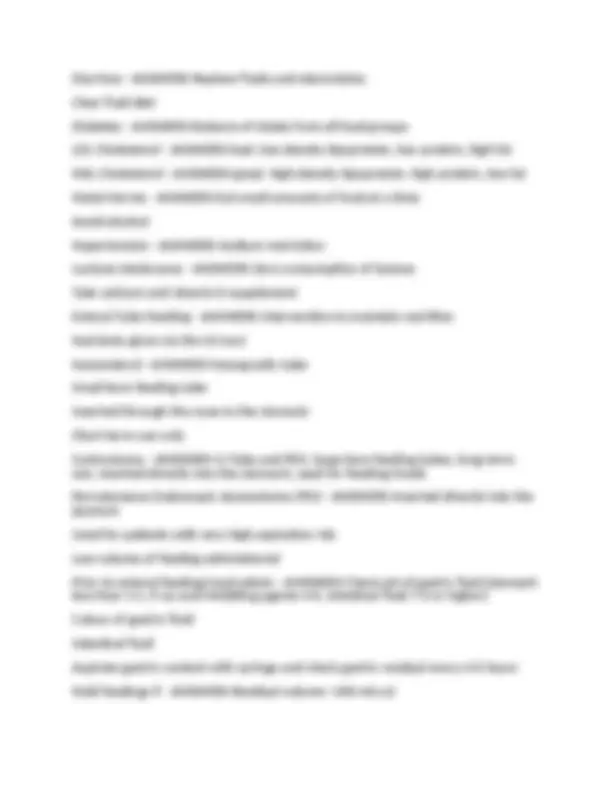
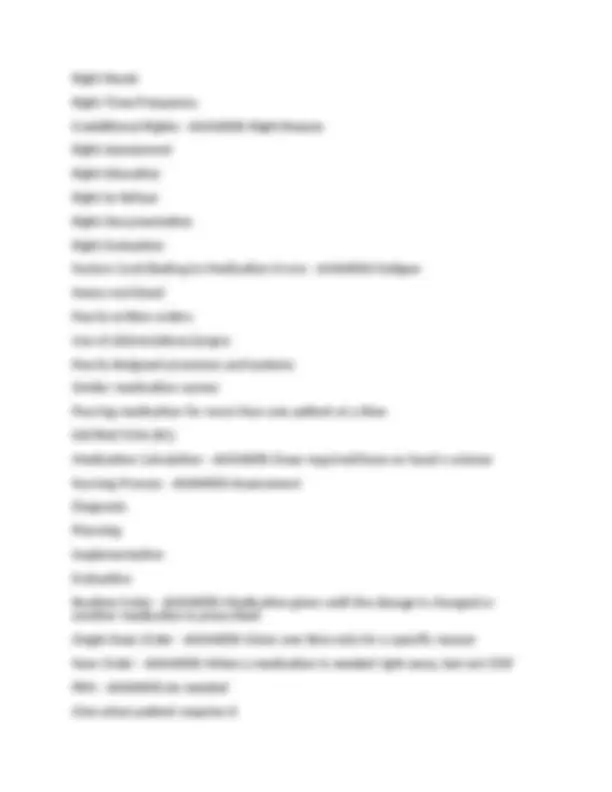
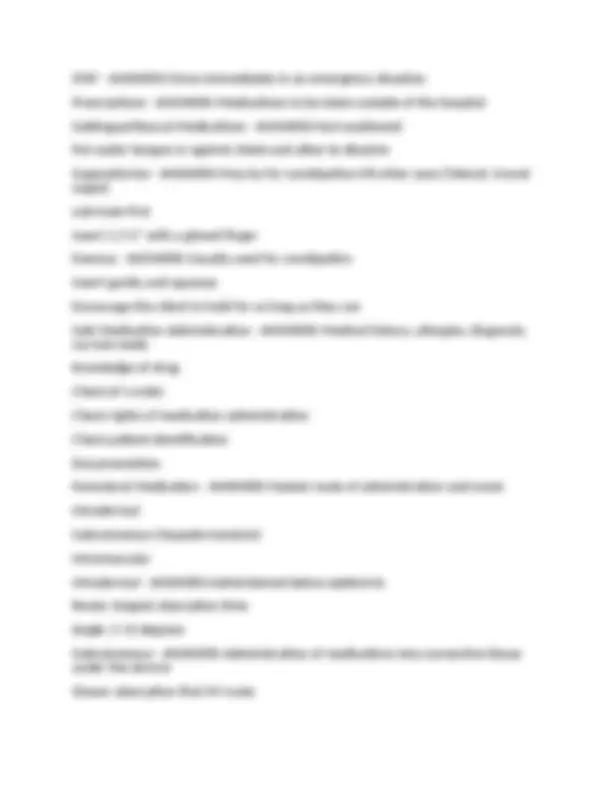
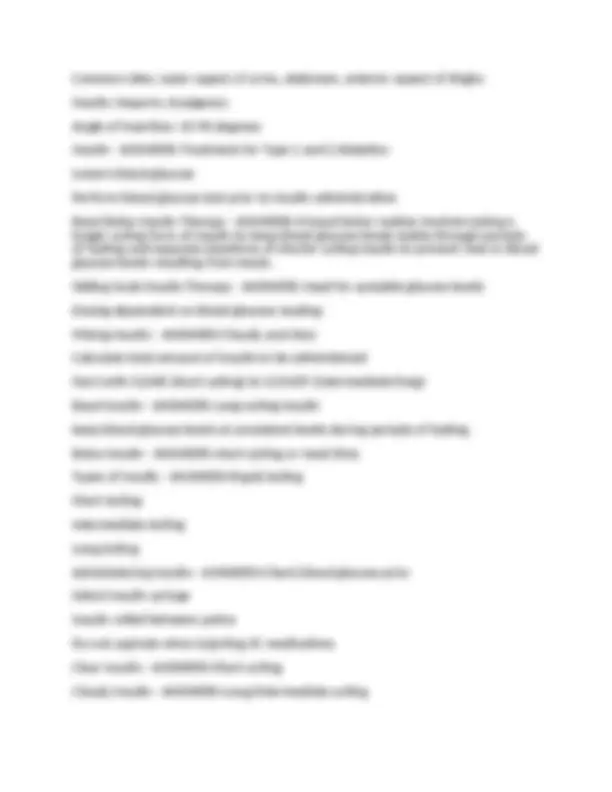


Study with the several resources on Docsity

Earn points by helping other students or get them with a premium plan


Prepare for your exams
Study with the several resources on Docsity

Earn points to download
Earn points by helping other students or get them with a premium plan
Community
Ask the community for help and clear up your study doubts
Discover the best universities in your country according to Docsity users
Free resources
Download our free guides on studying techniques, anxiety management strategies, and thesis advice from Docsity tutors
NFDN 1002 MIDTERM UNITS 1-4 Latest Update 2025 Graded A+ Pass. NFDN 1002 MIDTERM UNITS 1-4 Latest Update 2025 Graded A+ Pass.
Typology: Exams
1 / 16

This page cannot be seen from the preview
Don't miss anything!










Intrapersonal Communication - ANSWERS-communication with oneself Interpersonal Communication - ANSWERS-between two or more people Transpersonal Communication - ANSWERS-interaction that occurs within a person's spiritual domain SOAP Charting - ANSWERS-S= Subjective data (how the patient feels) O= Objective data (results of physical exam, vital signs, etc) A= Assessment (what is the patient's status) P= Plan (does the plan stay the same or is change needed?) SOAPIE Charting - ANSWERS-I= Intervention (what did the nurse do?) E= Evaluation (what is the patient outcome following the intervention?) PIE Charting - ANSWERS-P= Patient problems (teaching needs and discharge planning needs, identified during initial assessment of the patient) I= Interventions carried out for each specific nursing diagnosis E= Evaluate the outcomes of the interventions DAR - ANSWERS-Data: information that supports the focus Action: the nursing intervention Response: how the patient responds to the intervention and the outcome Focus Charting - ANSWERS-Eliminates the word "problem" and uses the term "focus" Includes patient's condition, nursing diagnosis, s&s, or significant event or change in condition Organized using DAR Source-Oriented Charting - ANSWERS-Most common Information is organized & presented according to its source There are separate sections for the doctor's notes, the nurse's notes, the respiratory therapist notes, etc Read through all the sections & piece together the data
Charting by Exception - ANSWERS-Chart only when there is a significant change or finding different from the norm Otherwise use standardized flow sheets, nursing database, SOAP progress notes and care plans CBE use narrative format Alerts staff to something unusual that has occurred with the patient Presumes that unless documented otherwise, all standards have been met with a normal response A.C. - ANSWERS-before meals P.C. - ANSWERS-after meals NKA - ANSWERS-No known allergies NPO - ANSWERS-Nothing per mouth HOB - ANSWERS-Head of bed W/C - ANSWERS-wheelchair SOB - ANSWERS-Shortness of breath PRN - ANSWERS-As needed TPR - ANSWERS-temperature, pulse, respiration Written Orders - ANSWERS-Physically written by the physician on the chart Verbal Orders - ANSWERS-Given to the nurse while in their presence Not written on the chart Telephone Orders - ANSWERS-Given to the nurse via telephone Electronic Orders - ANSWERS-Written through the electronic health system of the facility Processing a Verbal Order - ANSWERS-Verify Clarify Transcribe Factors that increase Fall Risk - ANSWERS-Age Fear of falling Footwear and foot care
Factors Influencing Hygiene - ANSWERS-Environment: living space Socioeconomic status: inability to purchase hygiene products, homelessness Individual characteristics and behaviours: Cultural considerations: influences self-care practices, preferences, and frequency, different perspectives on cleanliness and hygiene Cognitive and functional ability: ability to perform self care dependent on ROM, flexibility, mobility, balance, energy, motivation Patients with Diabetes: Care of feet and nails - ANSWERS-Only file the nails of patients with diabetes and Advise patients with diabetes to inspect feet daily for blisters, cuts, cracks, sores, redness, tenderness, or swelling Daily cleansing of feet with warm water and gentle soap is required FEET SHOULD NOT BE SOAKED B/C THIS CAN LEAD TO DRY SKIN WHICH CAN LEAD TO CRACKING Levels of Care: Level 0 - ANSWERS-Patient is independent in self-care activities Levels of Care: Level 1 - ANSWERS-Patient uses equipment/devices to perform self-care independently Levels of Care: Level 2 - ANSWERS-Patient requires assistance from another to complete self-care Levels of Care: Level 3 - ANSWERS-Patient requires assistance from another and uses devices or equiptment Levels of Care: Level 4 - ANSWERS-Patient completely depends on another for self- care Partial bed bath - ANSWERS-Washing patients face, hands, underarms, and perineal region Bed Bath - ANSWERS-Some patients cannot bathe themselves because they are too weak or comatose Factors that influence oral and mucous membranes - ANSWERS-NPO Dehydration Chemo or radiation Malnourished Immunosuppressed
Unable to perform oral care independently Infections Accumulation of excess cerumen is more likely in: - ANSWERS-People who use hearing aids People who put cotton swabs or other items into their ears Older people People with developmental disabilities Skin Assessment for Pressure Ulcers - ANSWERS-Assess difficult to reach areas for skin breakdown Assess perineal area Factors contributing to the development of pressure ulcers - ANSWERS-Pressure Shearing forces Friction Moisture Risk Factors for Pressure Ulcers - ANSWERS-Changes in sensory perception Level of skin moisture Nutrition and hydration status Mobility and circulatory status Fecal and urine incontinence Shear and friction Pressure Ulcer - ANSWERS-erosion of the skin caused by prolonged pressure, often occurring in bedridden patients Usually over a bony prominence 4 stages Braden Scale - ANSWERS-A tool for predicting pressure ulcer risk Scores can range from 6- Lower the score, the higher the risk
Tubes Complications Prevention - ANSWERS-Relieving pressure Positioning Improving mobility Improving sensory perception Promoting Skin Integrity - ANSWERS-Improving tissue perfusion Improving nutritional status Reducing friction & shear Minimizing irritating moisture Promote pressure ulcer healing Sterile Technique - ANSWERS-strategies used in patient care to reduce exposure to microorganisms and maintain objects and areas as free from microorganisms as possible. Involves hand washing, sterile field, sterile gloves for application of a sterile dressing, and the use of sterile instruments Surgical asepsis Clean Technique - ANSWERS-Washing hands, clean gloves, sterile instruments Medical asepsis Asepsis - ANSWERS-absence of pathogenic microorganisms Precautions with Occupied Bed - ANSWERS-Assess for activity restrictions Check bed for patient belongings Note presence and position of any tubes or drains Glycemic Index - ANSWERS-Shows effect on blood sugar of 50 g of carbohydrate in a given food
Glycemic Load Index - ANSWERS-Shows effect on blood sugar of a usual serving of a given food More accurate because some foods are high GI but low GLI because you would not eat 50 g of carbohydrate Proteins - ANSWERS-Essential for body tissue growth Fluid Regulation Fats - ANSWERS-Calorically dense Provide energy Vitamins - ANSWERS-Essential for metabolism Fat soluble Minerals - ANSWERS-Essential for biochemical reactions Nutritional Health History Assessment - ANSWERS-Diet - nutritional screening Weight changes Questions regarding fluctuations in weight Consistency with weight Consumption of fruits & vegetables Signs of Hydration - ANSWERS-Skin turgor Amount of urination Factors Affecting Nutrition: Culture, Religion - ANSWERS-Culture: balance with cold, hot, wet, dry, and influences meaning of food Religion: Dietary restrictions Factors Affecting Nutrition: Physiological Changes - ANSWERS-Changes in teeth and gum Reduced saliva production Deficiency in calcium Decreased thirst sensation Reduced gag reflex Decreased colon and esophageal peristalsis Factors Affecting Nutrition: Illness and Chronic Disease - ANSWERS-Diabetes
Diarrhea - ANSWERS-Replace fluids and electrolytes Clear fluid diet Diabetes - ANSWERS-Balance of intake from all food groups LDL Cholesterol - ANSWERS-bad. low density lipoprotein. low protein, high fat HDL Cholesterol - ANSWERS-good. high density lipoprotein. high protein, low fat Hiatal Hernia - ANSWERS-Eat small amounts of food at a time Avoid alcohol Hypertension - ANSWERS-Sodium restriction Lactose Intolerance - ANSWERS-Zero consumption of lactose Take calcium and vitamin D supplement Enteral Tube Feeding - ANSWERS-Intervention to maintain nutrition Nutrients given via the GI tract Nasoenteral - ANSWERS-Nasograstic tube Small bore feeding tube Inserted through the nose to the stomach Short-term use only Gastrostomy - ANSWERS-G-Tube and PEG: large bore feeding tubes, long-term use, inserted directly into the stomach, used for feeding/meds Percutaneous Endoscopic Jejunostomy (PEJ) - ANSWERS-Inserted directly into the jejunum Used for patients with very high aspiration risk Low volume of feeding administered Prior to enteral feeding/med admin - ANSWERS-Check pH of gastric fluid (stomach less than 5.5, if on acid inhibiting agents 4-6, intestinal fluid 7.0 or higher) Colour of gastric fluid Intestinal fluid Aspirate gastric content with syringe and check gastric residual every 4-6 hours Hold feedings if - ANSWERS-Residual volume >200 mls x
Large residual volumes - ANSWERS-High risk for aspiration Intermittent Feed - ANSWERS-Tube feed administered at specified times during the day Increase feeding as per order Intermittent Bolus Feed - ANSWERS-Tube feedings administered in large volumes over a short period of time Duration as per order Continuous Feed - ANSWERS-Tube feed administered in small amounts continuously Delivered at mL/hr Hourly rate increased ever 12-24 hours Increase by 10-20 mL/hr Water Flushes - ANSWERS-Maintain fluid and electrolyte balance Prevent dehydration Maintains patency of the tube Tube Feeding Initiation - ANSWERS-Always check orders (type, amount, and frequency) Xray confirmation most accurate Assess placement of large bore tubes only* (Assess placement- stomach contents pH and assess residual volume) Assess bowel sounds x4 quadrants Tube Feeding Initiation: Intermittent/Continuous - ANSWERS-Verify Dr's orders Auscultate bowel sounds before feeding Formula should be at room temperature HOB at least 300 - 450 Prime tubing with formula Administer pre water flush Set ordered rate, begin infusion Following administration, post water flush
Right Route Right Time/Frequency 6 Additional Rights - ANSWERS-Right Reason Right Assessment Right Education Right to Refuse Right Documentation Right Evaluation Factors Contributing to Medication Errors - ANSWERS-Fatigue Heavy workload Poorly written orders Use of abbreviations/jargon Poorly designed processes and systems Similar medication names Pouring medication for more than one patient at a time DISTRACTION (#1) Medication Calculation - ANSWERS-Dose required/Dose on hand x volume Nursing Process - ANSWERS-Assessment Diagnosis Planning Implementation Evaluation Routine Order - ANSWERS-Medication given until the dosage is changed or another medication is prescribed Single Dose Order - ANSWERS-Given one time only for a specific reason Now Order - ANSWERS-When a medication is needed right away, but not STAT PRN - ANSWERS-As needed Give when patient requires it
STAT - ANSWERS-Given immediately in an emergency situation Prescriptions - ANSWERS-Medications to be taken outside of the hospital Sublingual/Buccal Medications - ANSWERS-Not swallowed Put under tongue or against cheek and allow to dissolve Suppositories - ANSWERS-May be for constipation OR other uses (Tylenol, Gravol supps) Lubricate first Insert 1.5-2" with a gloved finger Enemas - ANSWERS-Usually used for constipation Insert gently and squeeze Encourage the client to hold for as long as they can Safe Medication Administration - ANSWERS-Medical history; allergies; diagnosis; current meds Knowledge of drug Check dr's order Check rights of medication administration Check patient identification Documentation Parenteral Medication - ANSWERS-Fastest route of administration and onset Intradermal Subcutaneous (Hypodermoclysis) Intramuscular Intradermal - ANSWERS-Administered below epidermis Route: longest absorption time Angle: 5-15 degrees Subcutaneous - ANSWERS-Administration of medications into connective tissue under the dermis Slower absorption that IM route
Insulin Pen - ANSWERS-Select pen Labeled with patients info Check cartridge Select special needle and attach to syringe Prime needle with 2 units of insulin Intramuscular - ANSWERS-Faster medication absorption Longer and heavier gauge needle Injection sites: Deltoid and ventrogluteal Angle of needle: 72-90 degrees Intramuscular Medciations: Z-Track - ANSWERS-Decreases pain Pull the skin laterally 1" away from injection site (non-dominant hand) Wait 10 secs before withdrawing needle Release tissue AFTER injection Seals in medication Medication sites should be rotated